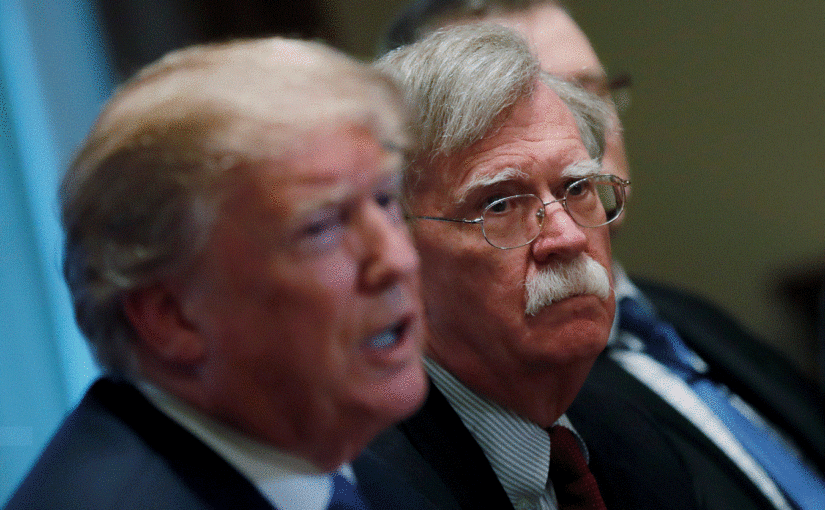From 2016 through 2019, the United States under the guidance and direction of Donald Trump was enmeshed in trade negotiations with China. For most of that time, the negotiations were rocky and a period of discord and confusion reigned. Things become worrisome, and as a result, the world economy went into a recession and things began to take on a very gloomy outlook.
Then, in October of 2019, it was announced that the trade talks were resolved and that Phase One of the trade negotiations would be implemented. Here we discuss these issues, trends and the related affairs that colored this sequence of events.
There is a lot to learn here, as it involves diplomacy, expectations, society, culture, manufacturing, the global environment, and industry. Rather than look at it from the simplistic black-and-white “cardboard cutout” of how it is presented in the American media, let’s look at it in detail. It’s a very interesting study of the affairs of men and nations.
We will start with a recap.
A Brief Historical Recap
The US-China trade dispute erupted publicly in March 2018.
Its origins, however, go back to August 2017, when the Office of US Trade Representative (USTR) issued a preliminary report charging that China’s ‘2025 Plan’ projected passing the US in next generation technology development (5G wireless, Artificial Intelligence, Cybersecurity).
Made in China 2025 is a strategic plan of China issued by Chinese Premier Li Keqiang and his cabinet in May 2015. With it, China aims to move away from being the world's "factory" and move to producing higher value products and services. It is in essence a blueprint to upgrade the manufacturing capabilities of Chinese industries. - Wikipedia
China’s plan represented a fundamental challenge to US global economic—and military—hegemony next decade, according to the USTR.
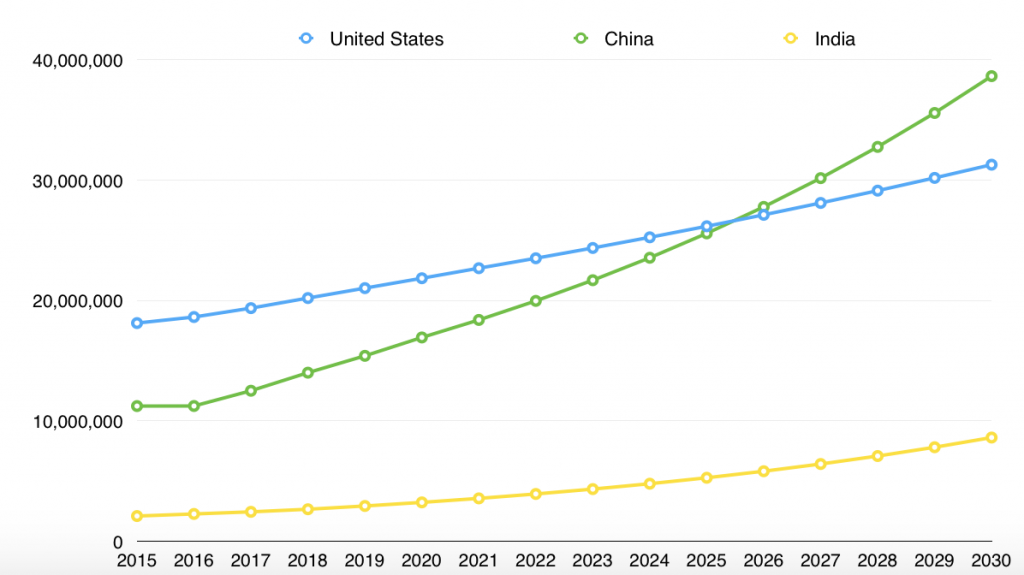
That initial USTR report was followed by a second report released in March 2018. That report concluded and confirmed what the first report had raised. Both reports argued that China represented a threat in nextgen technology development that the US could not ignore.
Dr. Christopher Ashley Ford, Assistant Secretary, Bureau of International Security and Nonproliferation, gave a speech at the Multilateral Action on Sensitive Technologies (MAST) Conference, in which he explained that “countries that choose Huawei technology are opening the door to Chinese access to their domestic networks and local companies, as well as potential surveillance by Chinese officials, posing a potential threat to their national security and economic well-being.” - State Department Highlights Chinese Technology Threats
The trade war with China only then commenced, with Trump imposing an initial $50 billion in tariffs on China imports.
An initial tentative agreement was reached between the main negotiators, the US team led at the time by US Treasury Secretary, Steve Mnuchin, in May 2018.

But you know, that tentative deal was quickly scuttled. The kibosh was put on it and it was shit-canned.
Neocons aborting the plan 1.
This is because US neocons, China hardliners, Pentagon, and the US Military Industrial Complex and friends in Congressional defense appropriations committees organized their forces and got Trump to nix the deal.
- Neocons Are Evil – LewRockwell
- Neoconservatism – Wikipedia
- Paul Craig Roberts: Neocons, An Evil That Is About To…
- Neocons Humanity’s Greatest Enemy – Rense
- The anatomy of a third World War: Neocon style
The scuttled deal included some serious concessions by China. That included [1] China agreeing to buy $1 trillion more in US farm goods over five years and [2] agreeing to allow US banks and financial institutions to have 51% ownership control of their operations in China.
These are really big deals.
But, the neocons would not have any of that. They wanted to rule the world and wouldn’t give an inch any way in any manner. Only America will be in charge. Only America can rule, tell other nations how to live and define the trade agreements. And if war is necessary to put other nations “in their place”, then so be it.
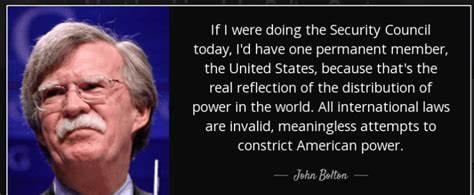
China reiterated their earlier (and substantial) concessions over the summer of 2018, but to no avail. The neocons would nave none of it.
The main issue was not the US trade deficit.
Nor IP guarantees.
Nor tech sharing of US companies in China.
Nor even majority ownership of US operations in China.
The main issue was the development of nextgen technologies—AI, 5G, and cyber. US Neocons aligned with the Pentagon-Military Industrial Complex, now led by Robert Lighthizer, the head of the USTR. These neocons did not want any nation to have any kind of technical superiority over America and they would fight it “tooth and nail” and economies, world trade, and prosperity be damned!
America MUST be number one, or nothing.
NOTHING!
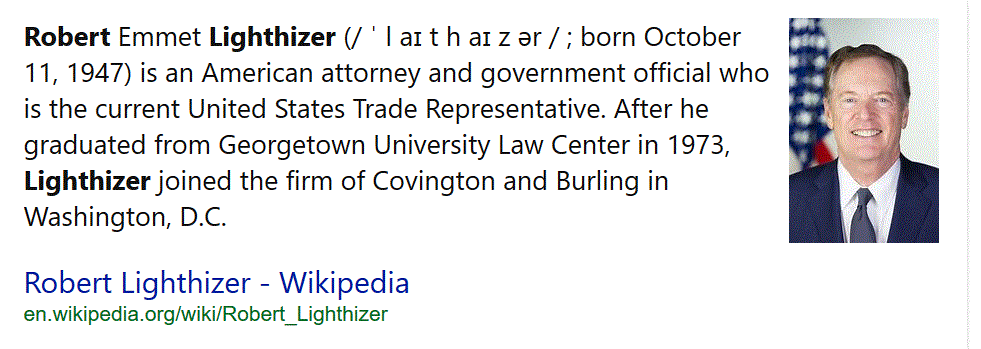
Other notable neocons included Peter Navarro, special trade adviser to Trump.
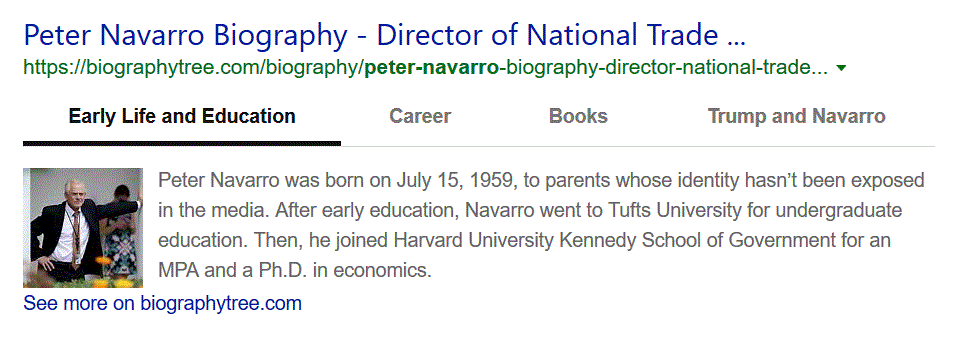
Not to forget the largest neocon of them all, John Bolton, who demanded China slow, and even share its nextgen technology development with the US, or else no deal!
"We want your technology and you WILL give it to us. If you don't well, we will put every pressure possible on you. And, oh by the way, don't think that we are not capable of planting swine flu to destroy all your pork products, launch revolutions and unrest in your cities, and maybe even sink a few ships if that's what it take to put you all in your place. America is the biggest, the best and the most powerful. Never forget that."
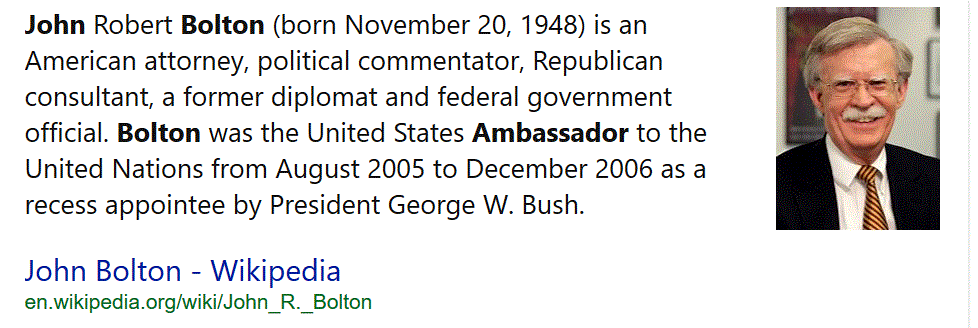
Seriously!
Negotiations stalled thereafter as Trump turned his focus to the NAFTA 2.0 negotiations and the 2020 midterm elections approached.
Six months burned away, and the trade negotiations, were dead in the water. The neocons convinced president Trump to “hold fast”, that China is still a third-rate nation and that the trade “wars” are sending China back twenty years.
But they were deluding themselves.
All the signs pointed to a reality that was at odds with American perceptions. Indeed, the Chinese had many “cards up their sleeves” and many of the assumptions that American advisors had on China were simply not true.
What’s worse, the American people started to notice this.
- Who Will Win the Trade War? Some Say China
- Markets send clear signal to US and China on the trade war
- China-U.S. trade war will last for ‘maybe 20 years,’ says …
- Worst case Trump-China trade war could sink stock market …
- Trade Wars: The Empire Strikes Back | Spengler
- The “Trade War” Is Over, Trump Just Doesn’t Realize It Yet
Negotiations were restarted in January 2019 after the midterm elections, and another five months of negotiations between the parties took place until another tentative deal was reached in May 2019.
Neocons aborting the plan 2.
That tentative deal once again was blown up at the last minute by the Lighthizer-Navarro neocon faction now in control of negotiations, with Mnuchin in tow as a co-chair.
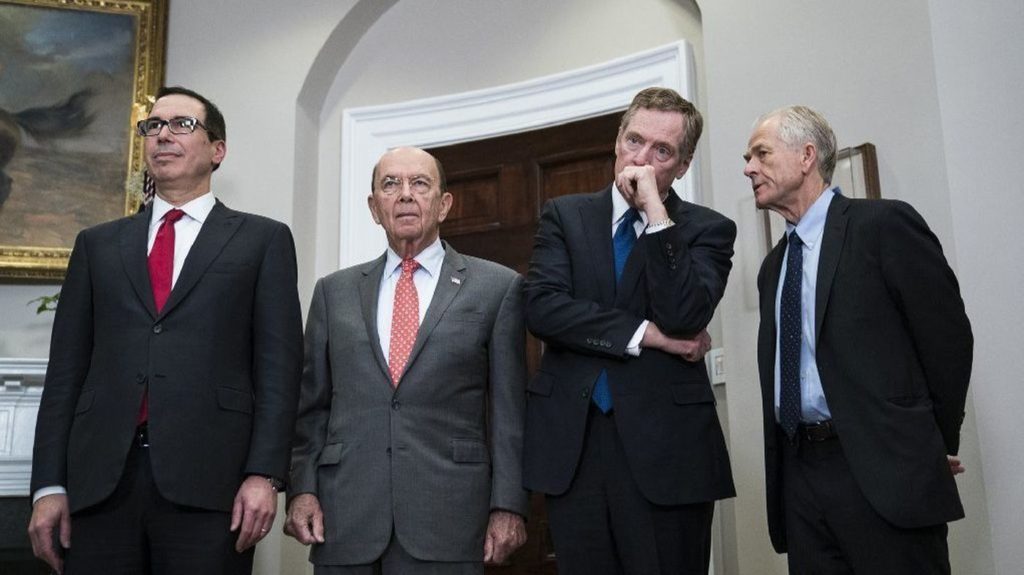
As the China delegation prepared to come to the US to sign off in May 2019, the US raised new additional demands:
- [1] China had to share its nextgen technology development with the US.
- [2] China to cease subsidizing its state owned enterprises.
- [3] China to provide assurances it would not devalue its currency to offset US tariffs (which now totaled $200 billion).
- [4] The existing US tariffs would remain in effect even if an agreement were reached. They would not be removed.
These were the new terms, “Too bad” they said.
All these demands were publicly communicated in the week prior to the May 2019 meeting in Washington D.C. when the deal was scheduled to be signed off.
It seems like they were totally and wholly devoted to terminating the deal, rather than trying to find some common ground from which to negotiate to in good faith.
Neocons aborting the plan 3.
Understandably, the China delegation came and returned home in a day.
The Neocons had scuttled a deal once again. Nextgen technology was the crux. Either China capitulated on nextgen tech or there was no deal, according to the Neocon-Pentagon position.

Trump thereafter met China president, Xi, in Osaka Japan at the G20 meeting. They both agreed once again to restart negotiations. Both also agreed to keep a hold on the level of existing tariffs and not raise them further in the meantime.
But Trump broke the pledge in late July 2019.
On the advice of his neocon trade negotiators, he raised tariffs on the remaining $250 billion of China imports. The understanding with Xi not to raise more tariffs was thus shattered.
China raised tariffs of its own on US goods in response.

Trump threatened to raise existing tariffs by another 5%, to 25% and 30%, and levy more on all the remaining China imports in December 2019.
The trade war was intensifying.
China took steps to stabilize the situation. China stopped intervening briefly in global money markets to prevent its currency, the Yuan, from devaluing and allowed it to fall 5%-7%–a move that essentially negated Trump’s additional 5% tariff hike.
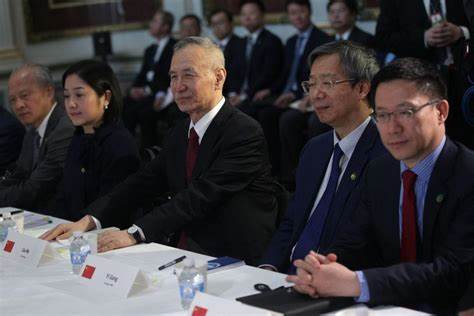
Stock and bond markets plummeted on the mere prospect of a trade war now morphing into a currency war. The trade war, based mostly on tariff hikes, was about to expand the economic conflict beyond mere tariff measures.
Uh oh!
It will be the USD (inflated with mountains of debt) against a rising currency the yuan (that represents the bulk of world wide manufacturing).
Tariffs were already slowing the global economy. A currency war would quickly spread beyond US and China and inject even more instability into the already slowing global economy.
Both China and Trump peered over the cliff of a pending broader economic war between the two economies—and then backed off.
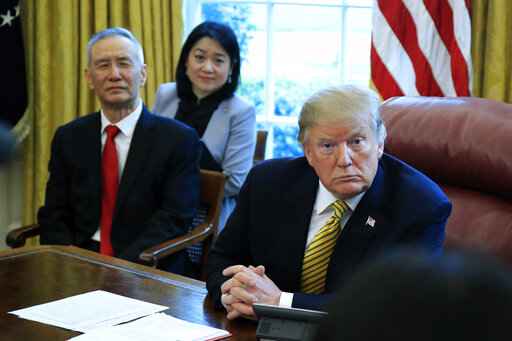
This continued all Summer until September 2019.
Fast forward, the outcome by September 2019 was yet another resumption of negotiations between the two parties, followed by the announcement of a ‘Phase 1’ deal on trade.
So why did Trump ‘stand down’ and agree to a deal now, after escalating his threats and actions over the summer?
The reasons pointed to American problems as a result of the “trade dispute”. You see, America was not as robust as the government would like everyone to believe. Thus, clearly it had to do with [1] the US economy softening in the 3rd quarter combined with [2] a growing discontent in the farm sector. This discontent is over Trump’s handling of the trade dispute that was beginning to bite hard on US farm sector sales. You see, American farmers were heavily dependent on exports to China.
![The reasons clearly have to do with [1] the US economy softening in the 3rd quarter combined with [2] a growing discontent in the farm sector. This discontent is over Trump’s handling of the trade dispute that was beginning to bite hard on US farm sector sales. You see, American farmers were heavily dependent on exports to China.](https://metallicman.com/wp-content/uploads/2019/10/5107_Fig5-1024x718.png)
As the trade dispute between the countries had intensified over 2018-19, Trump had placated farm interests by providing an extra $28 billion in direct farm subsidies.
But it wasn’t enough.
According to some sources, no fewer than 12,000 farms went bankrupt in 2018 alone. The $28 billion was going mostly to agribusiness and not getting down to independent farmers who needed it most.
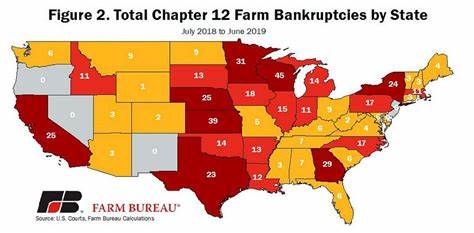
Farm sector trade associations were demanding Trump settle the trade dispute and their voices grew louder after the August escalation between the US and China.
"This trade war of YOURS is killing US. Please stop it, resolve it, or do whatever it takes, and do it soon. You are killing us!"
So too were other notable business groups, like the US Chamber of Commerce and Business Roundtable, raising their complaints about the now rapid deterioration of the negotiations.
"I thought that we would come to a mutually fair and agreeable trade agreement. Not one that is contentious, where we are making all the demands, and forcing China into a corner in which they will never agree to. This is not only stupid in the short term, but unwise in the long term. STOP POKING THE PANDA BEAR!"
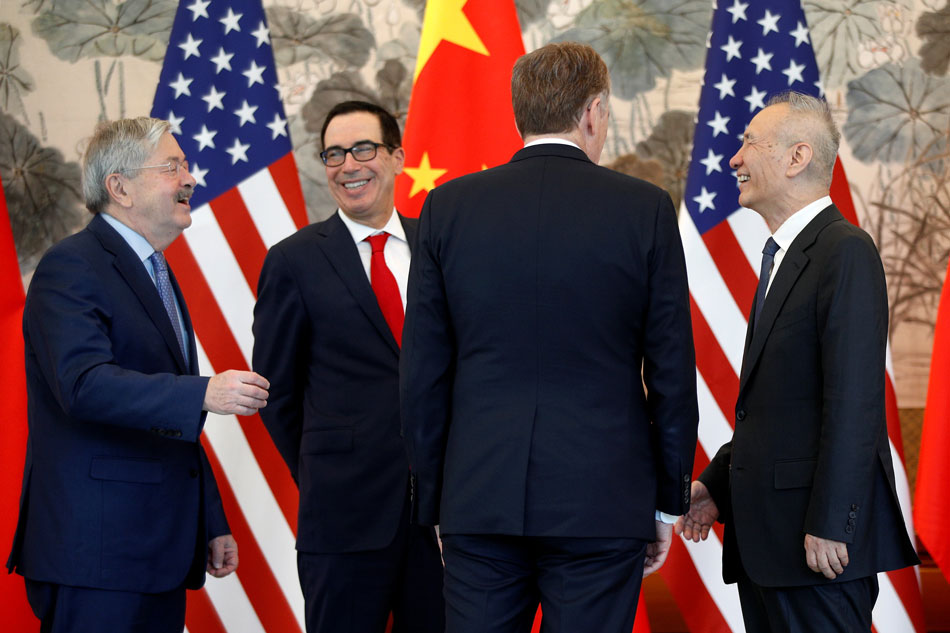
The trade war was beginning to clearly impact general business investment and manufacturing in the Midwest US, and not only in the US but worldwide.
The entire global economy started to slow affecting everything and everyone.
- World Economic Outlook, April 2019: Growth Slowdown
- 2019 Global Economic Recession Or Just A Slowdown?
- The World Economy: Synchronized Slowdown, Precarious
- Darkening Prospects: Global Economy to Slow to 2.9 percent
- Global growth to slow in 2019, says World Bank – The Hindu
- What to expect for the global economy in 2019
- The global economy is slowing down.
US business investment on new plant and equipment turned negative in the 2nd quarter and promised to continue to slump, while business inventory investment was also being pared. If actions wouldn’t reverse, the entire “deck of cards” could go “belly up”.
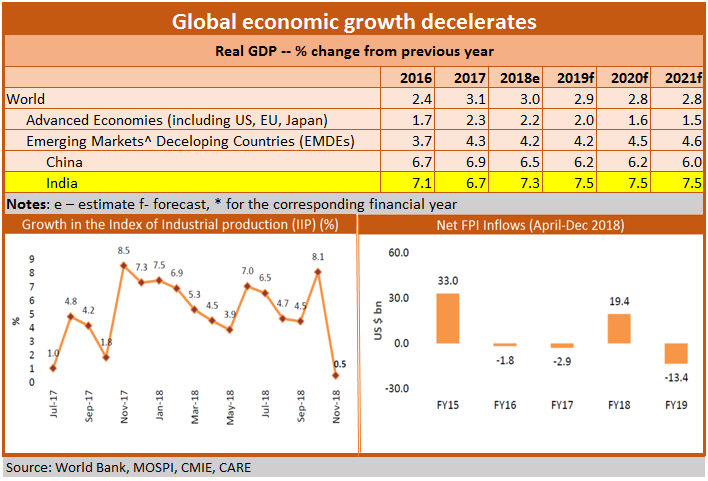
The trade war was beginning to impact beyond the farm sector.
By August the US manufacturing sector began to contract, joining what had now become a global manufacturing recession.
Moreover, at the end of August it was also beginning to appear that the manufacturing contraction in the US was potentially spilling over to the larger services sector.
While manufacturing PMIs were contracting in the US, the even larger Services sector PMI had begun to decelerate sharply in terms of growth rate.
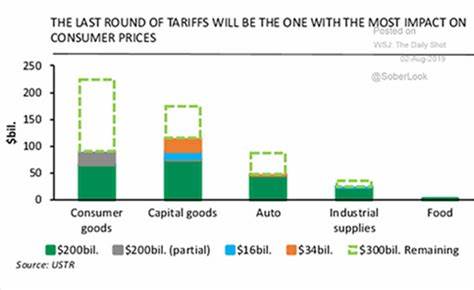
Of equal concern, the new round of Trump tariffs on consumer goods now threatened to slow US consumer spending—the only sector of the economy still holding up in terms of growth. If it does in fact impede growth, there could be disastrous consequences for America, Americans the reelection chances of Donald Trump.
"A key measure of consumer spending unexpectedly dropped for the first time in seven months in September, raising concerns about one of the brightest spots in the US economy. The Commerce Department said Wednesday retail sales fell 0.3% last month, the first decline since February and compared with a 0.6% rise in August. Retail sales account for more than two-thirds of economic output. Consumer activity, along with hiring, has propelled an economy that has been otherwise roiled by a trade dispute between the Trump administration and China."
Chase bank research was estimating that, with the new Trump tariffs on China consumer good imports set for September and December, consumer spending would be reduced on average by no less than $1,000 per household.
It was this growing economic slowdown in the US—combined with the growing political discontent in the farm sector and from other major non-farm business organizations—that pushed Trump to concede to the Phase 1 deal.
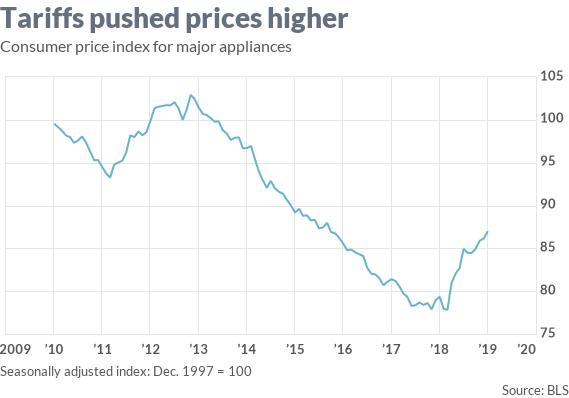
Trump may say, and believe, that “billions of dollars will soon be pouring into our Treasury from taxes that China is paying for us,” but China isn’t paying the taxes. U.S. consumers are. And as for the president’s belief that tariffs will “cure” the nation’s trade deficit, which he sees as a sign of weakness, today’s data suggest otherwise.
The study found that the waves of tariffs throughout 2018 resulted in “substantial increases” in the prices of intermediate and final goods, the cost of which was borne entirely by U.S. consumers. There was little improvement in the “terms of trade,” which means exporters didn’t lower their pre-tariff prices. And the higher price of imports enabled U.S. producers to raise their prices. What’s more, the tariffs introduced inefficiencies by disrupting supply-chain networks. And the customs duties were insufficient to offset the loss to consumers.
Trump’s 2020 election interests had become more paramount than the concerns of the neocons and militarists who were demanding China capitulate on the nextgen tech issue or no deal.
A rapid about face by Trump occurred by late August-early September and China was once again invited to resume talks in Washington in early October.
The content of the Phase 1 deal reached October 11, 2019 reveals that Trump abandoned his ‘big deal or no deal’ position. He retreated from the neocon ‘non negotiable’ demand, that was holding up a deal since May 2018. This demand was that China capitulate on the nextgen tech issue or no trade deal.
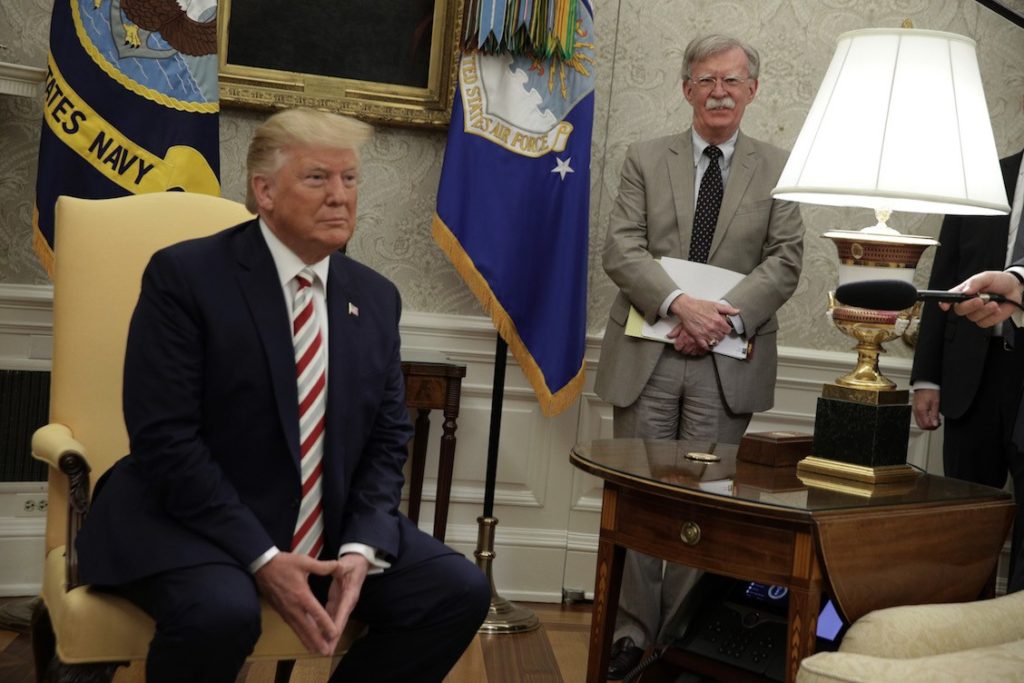
Placating his farm sector political base to get China to resume purchases, and taking China’s 51% ownership concession desperately wanted by US big banks (i.e. the primary demand of the Mnuchin faction on the US negotiating team), became Trump’s new priority demand in Phase 1.
Neocon John Bolton fired.
The nextgen technology issue so critical to the neocons was clearly demoted and removed from the bargaining table by the US.
In Phase 1 China got its ‘partial’ deal—and absent any concessions on the nextgen tech issue. That was left for a Phase 2 or even Phase 3, as Trump put it in his press conference the same day.
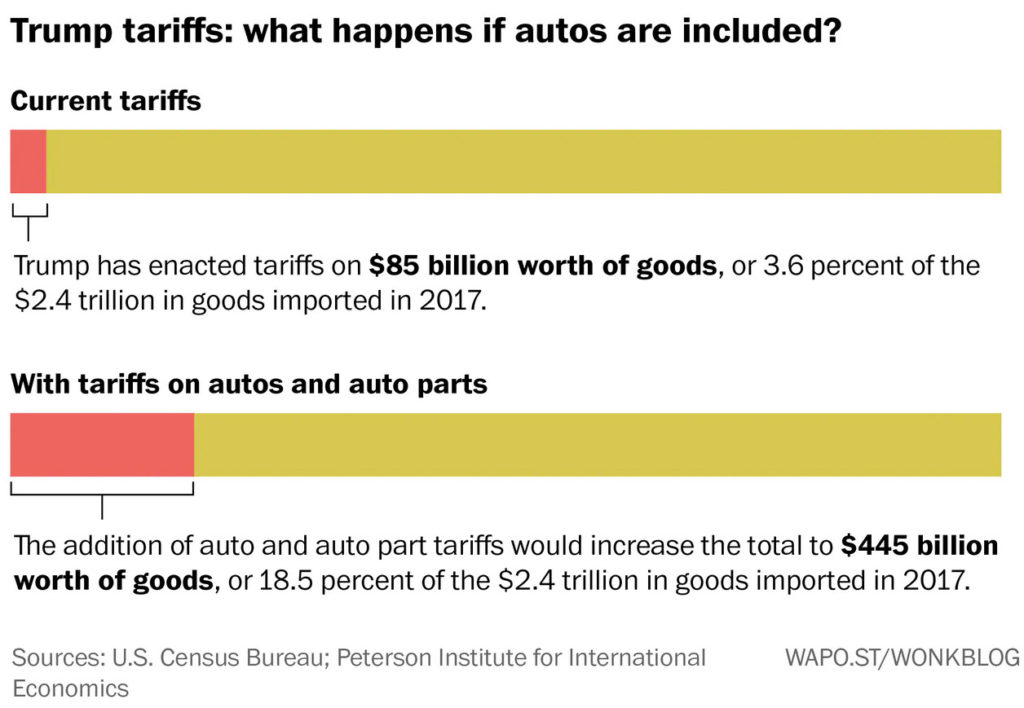
Trump got what the China delegation had already offered way back in 2018: i.e. 51% ownership and resumption of big purchases of US farm products.
In short, Trump caved in and in effect “took the money and ran”. His 2020 re-election interests took precedence over the neocon-military concerns over China’s nextgen tech development. He announced to the world that the USA and China came to an agreement and trade deal.
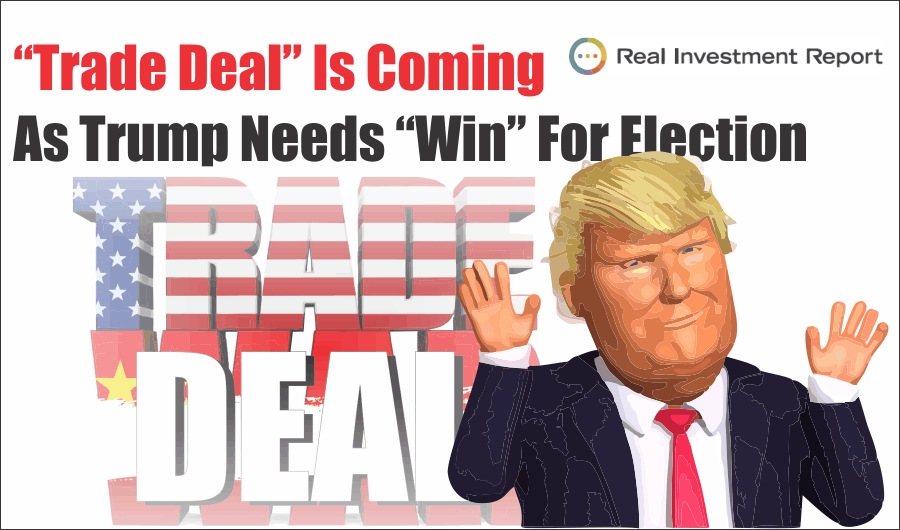
What’s In the Phase 1 Deal?
Important to note, the Phase 1 deal itself is not yet a signed agreement. It’s a verbal understanding between Trump and China’s vice-premier and chief negotiator, Liu He.
In his press conference announcing the deal on October 11, Trump admitted the parties were yet to sign off even on Phase 1 but hoped that it could be done within 5 weeks; that is by the time Trump and Xi meet again at the APEC conference in Chile in November.
- Increased purchases of farm products by China.
Trump boasted repeatedly the Phase 1 deal included up to $40-$50 billion in new US farm purchases by China.
Over what period was not clear, however. Trump vacillated from saying current levels of China farm purchases were $8 billion, or maybe $16 billion, or was $17 billion at prior peaks. He really didn’t know. Or maybe it was $20 billion, as one side comment was made in the press conference. It sounded like $40 billion was the target agreed to in principle and over the course of the next two years.
But that was the ceiling apparently.
Trump declared there’s “never been a deal of this magnitude for the American farmer”. Of course that wasn’t true. But the Trump hyperbole and spin was in.
- Americans can have controlling interest in their companies on Chinese soil.
Another major agreement area in Phase 1, according to Trump, was China’s confirmation it would allow US companies to own 51% of their operations in China. As Trump put it, “banks will be very very happy”.
More US multinational corporations could now shift even more production to China.
- A Suspension of an additional 5% tariff hike over the already applied 25% tariff hike.
On the important tariff front, in Phase 1 Trump agreed only to suspend his threatened 5% tariff hike (raising rates from 25% to 30%) due the following week of October.
What’s NOT In Phase 1
What’s not in Phase 1 reveals clearly that Trump clearly capitulated on the nextgen tech issue in exchange for resumption of farm purchases and the 51% US bank ownership in China offer.
- No Intellectual Property protections.
What was agreed to in ‘IP, or intellectual property’ protections was left vague in Phase 1. Trump admitted only some IP issues were included in Phase 1 but didn’t say what. IP was mostly left to Phase 2, per Trump.
- No details on how China can control the value of the yuan.
Equally vague was the understanding in Phase 1 on how China might agree not to devalue the Yuan, its currency. That was key to the US since devaluation would offset Trump tariffs.
Trade representative, Lighthizer, provided some vague commentary during the Trump press conference about how China and the US would meet to work out some rules in that regard. But the devaluation issue itself was irrelevant.
China had consistently over the preceding 15 months of trade war intervened in money markets to keep its currency from devaluing, and did so even as the rising US dollar was the primary cause of the pressure on the Yuan to devalue, as it other currencies worldwide as well.
If anything was driving the devaluation it was the rising US dollar, not a policy action by China to enact a devaluation.
- No action on nexgen technology.
Tech issues were in general put off.
As Trump declared, would be “largely done in Phase 2”, or maybe even a Phase 3. And Phase 2 would not begin until and if Phase 1 verbal understandings were ‘signed off’ in writing five weeks from now by Trump and Xi in Chile.
Further revealing no agreement on the strategic nextgen tech issue, Trump indicated the US would continue its policy attacking China’s 5G tech company, Huawei, as well as selectively ‘blacklist’ other Chinese AI companies in the US.
That was, he added, “a separate process”.
So the nextgen tech issue is now a separate track, in effect decoupled from the trade negotiations. It is very unlikely it will be reintroduced in Phase 2, should that subsequent round even occur, which is not likely in any substantive way before the 2020 US elections.
- No reduction on existing tariffs.
Also left out of Phase 1 was any US reduction of existing tariffs on China imports. That continuation of tariff levels included the $160 billion of China consumer goods exports to the US scheduled for December 15, 2019.
- China can continue to subsidize it’s state-owned businesses.
The US also apparently failed to attain its demand that China reduce its subsidies to its state owned enterprises—a strange proposal given that the US just subsidized its business sector with trillions of dollars with Trump’s 2018 tax cuts.
Phase 1 completed articles of interest.
- Trump announces ‘phase one’ trade deal with China
- Trump says US has come to a substantial phase one deal
- Trump Reaches ‘Phase 1’ Deal With China
- US-China Mini-Trade Deal: Trump Takes the Money and Runs
- Trade Deal With China Is a Blockbuster | Power Line
How and Why Trump Folded in the Trade War with China
As usual, Trump talked tough before his G20 meeting with Xi Jinping in Osaka, Japan.
“China will face 25% tariffs on the $300 billion of the remaining imports,”
It was frightening and terrifying, and the world shook. But lo and behold, he not only came up empty handed, but he also caved in numerous ways, including reversing his ban on Huawei.
What happened?
To summarize Trump’s astonishing loss at the negotiations with China:
- He didn’t raise new tariffs (on the $300 billion of Chinese goods)
- He reversed his ban on Huawei as well as eight other Chinese hi-tech companies, which were sentenced into the “entity list” just a month and half ago. (Now the whole “Huawei is a security threat” has been revealed as an utter hoax!)
- He accepted more talks (though, without any deadline targets).
In exchange for all of this, all Trump got was China’s promise to buy more agricultural goods. Ah yes. Once again soybeans and farmers play an immense role in trade decisions.
Tech Bomb Neutralized
How did this happen?
First, China quickly neutralized Trump team’s “nuclear option”. With that option (or idea) being to shut down Huawei, at all levels, in the United States.
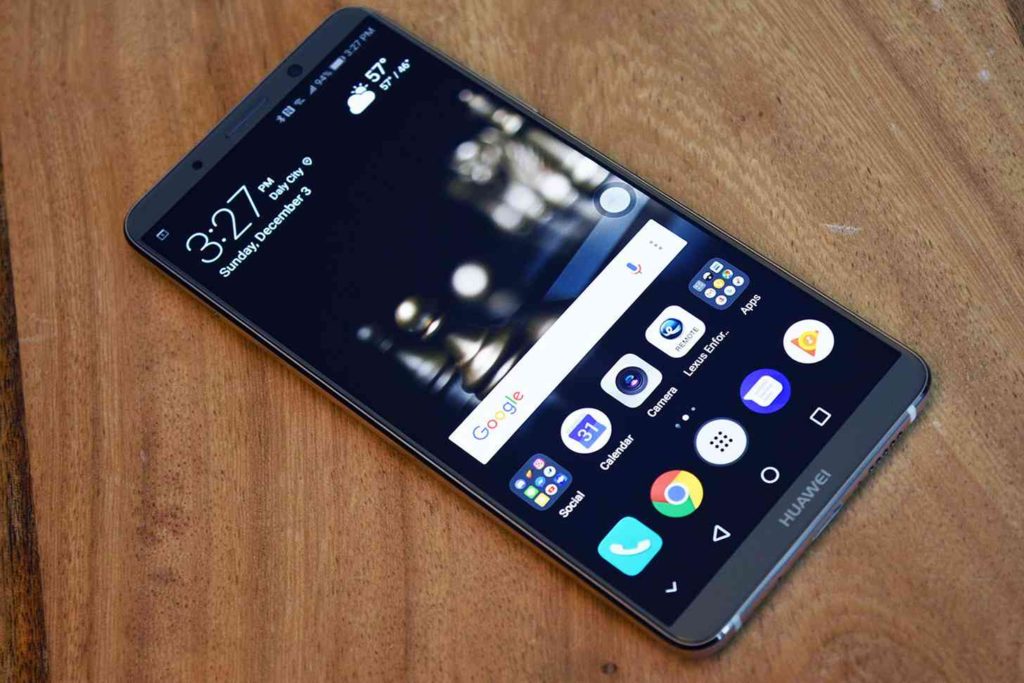
It’s not a bad play. As it has worked before.
The US was trying the same playbook that worked with Japan in the 1980s. That time, the US banned Toshiba to bully Japan into the infamous Plaza Accord. But, don’t you know, China isn’t Japan!
The Plaza Accord or Plaza Agreement was an agreement between the governments of France, West Germany, Japan, the United States, and the United Kingdom, to depreciate the U.S. dollar in relation to the Japanese yen and German Deutsche Mark by intervening in currency markets. -Wikipedia
This time, however, was different.
Indeed, China and Huawei had a surprise for the US team. Huawei announced that it had been preparing for just this kind of an emergency for many many years.
They were ready.
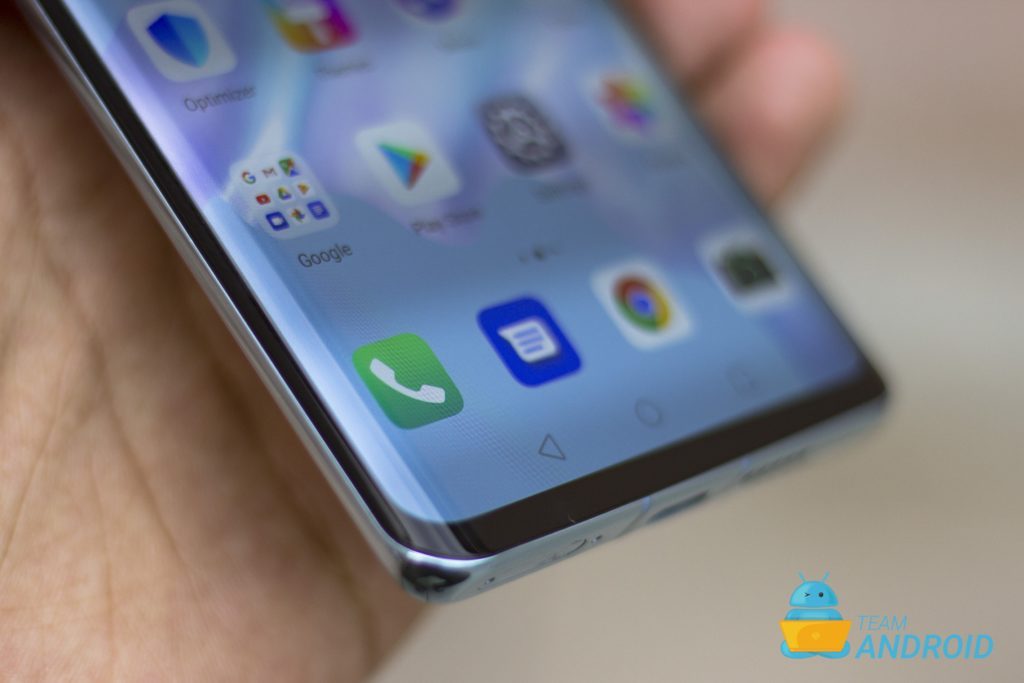
Huawei’s CEO (Ren Zhengfei) went on the offensive.
Ren Zhengfei. Born on October 25, 1944 in the small, mountainous province of Guizhou, China, Ren Zhengfei is the founder and CEO of Huawei Technologies, one of the largest telecommunications and mobile telephone companies in the world. Ren Zhengfei is a trained engineer. - Ren Zhengfei - Corporate Executives
With the media hounding him for rebuttals and sound bites, he responded in a measured and methodical manner. In all, he laid out some pretty surprising comments and announcements. In which [1] he claimed that HiSilicon (a Huawei subsidiary) can make most of the semiconductor chips that Huawei uses, and [2] that Huawei has been working on a secret operating system (“Hong Meng” or “Ark OS”) that can replace both Android and Microsoft Windows!
- Huawei did not need American semiconductor chips.
- Huawei did not need American or Korean operating systems.
Some media outlets reported that this OS, referred to as "Hongmeng OS", could be released in China in either August or September 2019, with a worldwide release in the second quarter of 2020. On 24 May 2019, Huawei registered "Hongmeng OS" as a trademark in China. - Harmony OS - Wikipedia
He said that Huawei has been working on this secret project since 2012.
The reaction on the social media was unmistakable. Make no mistake. Anyone who was not an American was rooting for Huawei. Yes, the “underdog” which sold 200 million smartphones last year and half of them were outside China.
Hisilicon Technologies Co., Ltd. (海思半導體) is a Chinese fabless semiconductor company wholly owned subsidiary of Huawei. Founded in 1991 as ASIC Design Center of Huawei Technologies Co., Ltd., HiSilicon became an independent, wholly owned subsidiary of Huawei in 2004. - HiSilicon - WikiChip
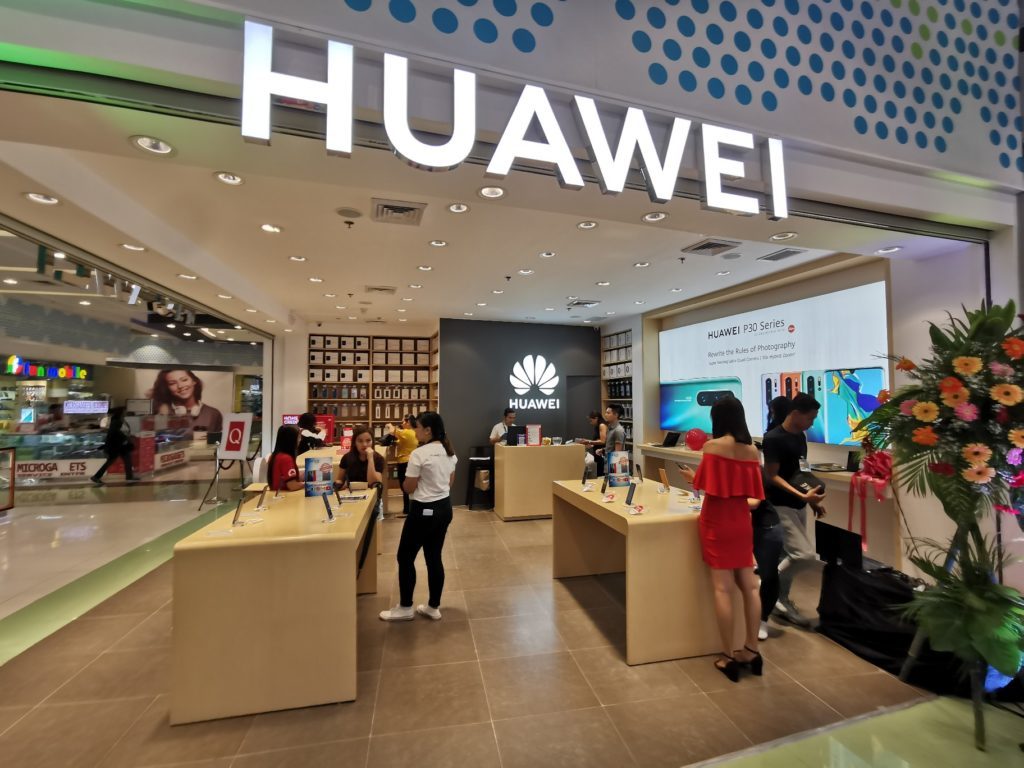
Americans had no idea. The Trump negotiation team were blindsided by this. American industry were stunned.
Now, Google and Microsoft were scared.
What if Huawei really launched a good decent OS that can take on Android and Windows? Worse, what if all the other Chinese smartphone companies switched to Hong Meng?
About 65% of worldwide Android users are using Chinese brands!
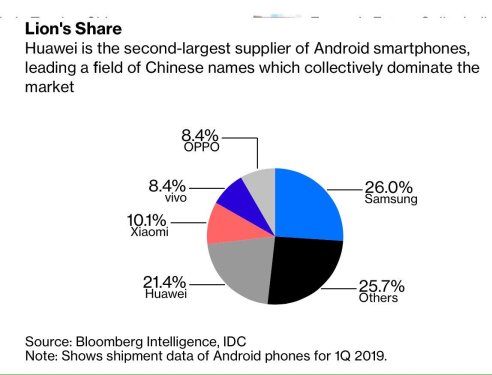
While the US was trying to kill Huawei, it seemed like Huawei was about to kill Android.
The roles were reversed, and America wasn’t ready.
And the implications are far worse.
For the US would lose all its abilities to spy on the world, if both the hardware and the software are Chinese! Truth be told, this is the real reason why Google started lobbying the Trump administration to lift the ban on Huawei.
As for the US semiconductor companies, they also started seeing signs of Chinese independence in the chip-designing area.
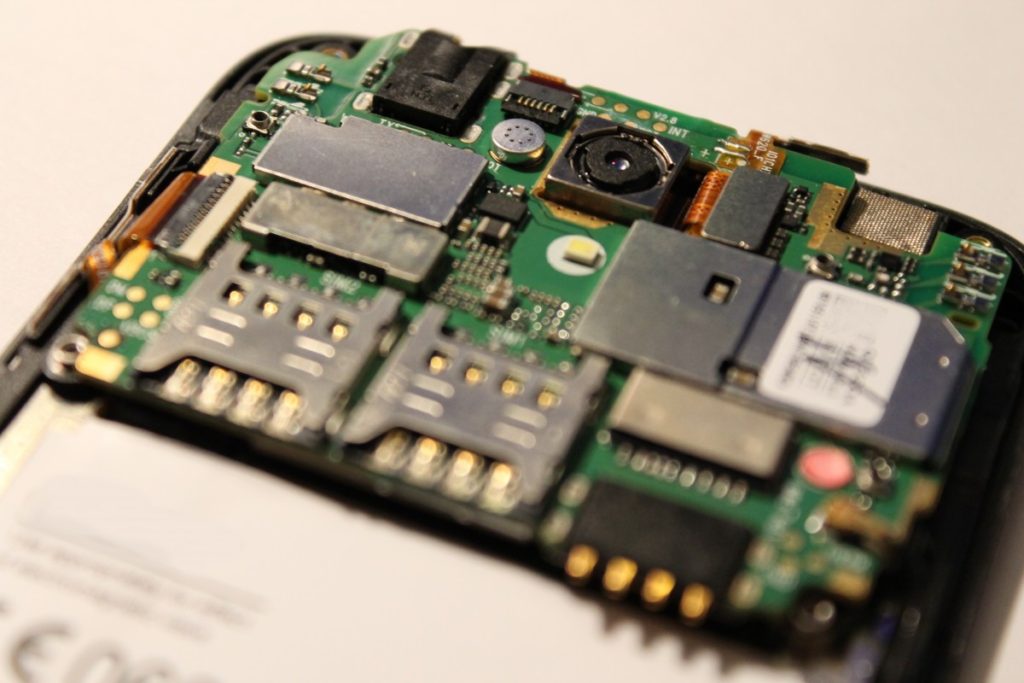
China announced a new home-grown CPU that could compete with Intel and AMD. This would be the first time a non-American company would make its own CPU. And another Chinese company announced it will start mass production of memory chips (DRAM).
To summarize: US plans for crushing Huawei fell flat and (depending on your point of view) even backfired.
US plans for crushing Huawei fell flat and backfired.
Chinese Economy
How about China’s economy? Are Trump’s tariffs crushing the Chinese economy? Was China on the verge of collapse due to starvation, famine and a rising tide demanding “democracy”?
Not really.
Of course, you wouldn’t be able to tell, with the American propaganda machine in full force, churning out bullshit…
"China’s economy grew at mere 6 per cent in the third quarter of 2019 compared with a year earlier, its slowest pace in about 30 years, delivering another blow to global growth and underlining many of the challenges facing President Xi Jinping. The country’s trade war with the US, slowing income growth and cooling manufacturing investment took a toll on the world’s second-largest economy between July and September, according to the figures released by the (American) National Bureau of Statistics on Friday." - The Worst Chinese Economy in 30 Years
Meanwhile, the American economy is roaring forward ever skyward…
"The Gross Domestic Product (GDP) in the United States expanded 2.30 percent in the second quarter of 2019 over the same quarter of the previous year. GDP Annual Growth Rate in the United States averaged 3.20 percent from 1948 until 2019, reaching an all time high of 13.40 percent in the fourth quarter of 1950 and a record low of -3.90 percent in the second quarter of 2009." - United States GDP Annual Growth Rate | 2019
Um… I might not be the smartest fellow in the world, but I am pretty sure that 6.0% is a lot better than 2.3% growth. No matter how you look at it.
What’s going on?
During Jan-May 2019, China’s exports to the US fell about 5%, but China’s exports to the EU rose more than 14%. And, guess what, EU is China’s #1 trading partner (and ASEAN is the #2 trade partner), while the US is #3.
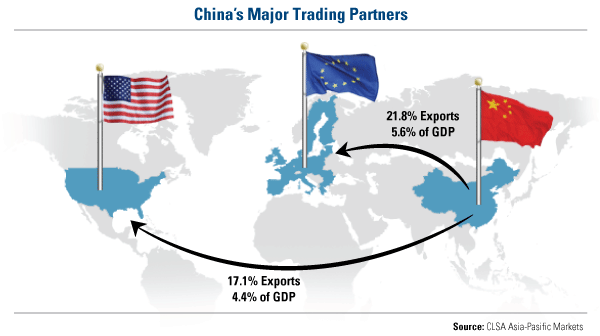
So, China keeps growing at a healthy pace. In fact, the IMF predicts a healthy 6.2% real GDP growth for China this year!
But here’s the kicker.
While China’s exports to the US fell 4.8%, the reverse — US exports to China — fell by a whopping 24% (for the first five months of 2019).
The talking is over. Now we’re fighting a real trade war — and here on my farm in Iowa, I’m on the front line. The dispute between the United States and China poses a direct threat to my livelihood. Because of the new and emerging tariffs on both sides, the things I grow will sell for less and the things I buy will cost me more. This week the price of hogs dropped $12 for every pig I sell. This morning, soybeans are down 40 cents a bushel — a $1.7 billion loss to the value of U.S. soybeans. And if I want to make new capital purchases of machinery or grain bins — anything made with steel or aluminum — I’ll have to pay a higher amount. For years, we’ve engaged in a war of words with China over trade. American officials have complained about everything from China’s currency manipulation and subsidized industries to a trade deficit that hit a record level in 2017. The difference between what Americans bought from China and what Chinese bought from the United States reached $375 billion last year. President Trump recently demanded that the United States reduce this gap by at least $100 billion. Last month, Trump fired a salvo, announcing new tariffs of 25 percent on imported steel and 10 percent on imported aluminum. China retaliated a few days ago with a long list of new tariffs, affecting about $50 billion of American-made products. Many fruits and nuts, for example, will face a 15 percent tax. So will a variety of stainless steel pipes. China also slapped a 25-percent tax on pork products — a category that affects me directly because I raise hogs. We try to sell every part of these animals, from the meat to the offal. Even before the trade war erupted, pork prices weren’t very good. Now they have dropped to the lowest prices since 2003. Now things are going from bad to worse. The Trump administration responded on Tuesday by proposing more than 1,300 new tariffs on Chinese products, including televisions, chemicals and machinery. They’re also worth about $50 billion, in a tit-for-tat move that aims to match China’s latest round. Now China has shot back. On Wednesday, it added tariffs to more than 100 U.S. products, including cars and planes. This round affects me, too. If the Chinese impose the announced tariff of 25 percent on soybeans, another major product on my farm, it will lower my price $2.50 a bushel. China isn’t the only market for my pork and soybeans. Reducing our access to this important destination, however, has global repercussions. The bottom line is that what I produce is suddenly worth less money. My competitors in Argentina and Brazil must be celebrating their good luck. What will tomorrow bring? Nobody knows. Today, however, is bad enough: My farm business is now under siege, held hostage by a trade war that my neighbors and I never wanted. Yet, U.S. Trade Ambassador Robert Lighthizer says we can’t worry about me, it is the big picture that is important. All I can say to him is that the financial bullets are real, and they hit with real impact on us in agriculture. To be sure, Trump isn’t doing anything he said he wouldn’t do. He has talked tough on trade from the moment he announced his candidacy. I supported his election, but also harbored deep reservations about his trade agenda. Now my fears have come to fruition. My hope is that the president will make good on the promise that he’s a master negotiator. Perhaps he’ll bargain his way out this mess. Many of the new tariffs have yet to take effect. They’ve already shaken markets and taken an economic toll, but they are threats rather than realities. Perhaps a round of productive bargaining will sweep them away. - Impact of Chinese trade war: What American farmers produce is suddenly worth less money
So, US exporters and farmers are hurting real bad.
- Trump has angered the wrong people: Farmers
- Donald Trump has emasculated the American farmer
- US farmers are not happy with Trump’s NAFTA threats
- American farmers worry they’ll pay the price of Trump’s
And Trump cannot win re-election without the support of those “great soybean/corn/pork farmers.”
As for the tariffs on the last $300 billion of imports from China, 600 major US corporations and influential trade groups — Walmart, Nike, Apple etc. — strongly lobbied against the tariffs and held a few days of hearing/testimony with the US Dept. of Commerce.
Behind the doors, corporate lobbyists were probably threatening US politicians — “If you don’t stop these tariffs, we will fund your opponent in the coming election and destroy you!”
Then, to really really rub it in, Apple announced one day before the G20 meeting that they were going to move manufacturing of high-end desktop computers (Mac Pro) from the US to China!!!
- Apple to Manufacture New Mac Pro Computer in China
- Apple is moving its new Mac Pro production from US to China
- Apple Moves Mac Pro Production to China – WSJ
- Report: Apple to shift assembly of Mac Pro from US to China
Ouch!
Yes, it is true, China can cripple the US economy in many ways. Rather than actually carrying out these threats, the Chinese government warned US corporations whose subsidiaries are making hundreds of billions of dollars every year in China — note that this is not reflected in the official trade surplus/deficit calculations.
Then China made these corporations lobby the Trump administration. This is much more effective.
At the same time, China has also been opening up certain sectors in the last month. For example, Morgan Stanley was allowed to become a majority holder in its joint venture; and US corporations would be free to compete in oil/gas sectors in China. Such actions create allies who will put the pressure on US politicians to not escalate the trade war.
As for manufacturing, China is moving ahead with artificial intelligence, robotics, 5G, IoT etc. The Chinese really don’t want to be stuck with low-end manufacturing. If some of these jobs move to Vietnam, Thailand etc., that’s fine.
- Understanding China’s Technological Rise – The Diplomat
- Nasdaq NexGen Economy China ETF – marketwatch.com
- China Remains a Huge NexGen Opportunity – InvestorPlace
- China’s rise as a major contributor to science and technology
China needs only four or five more years before it fully catches up with the US in major sectors such as semiconductor, biotechnology and civil aviation. While the Chinese government has officially stopped talking about “Made in 2025,” you can bet it has been accelerated to “Made in China 2023.”
Thus, the Chinese government’s plan is to just ride out America’s temper tantrum for a few more years.
The US needs a completely new paradigm for the 21st century. Unfortunately, Washington elites are totally clueless.
Washington elites are totally clueless.
Sun Tzu said, “strategy without tactics is the slowest route to victory, but tactics without strategy is the noise before defeat.” The latter approach is more appealing to Trump, the real estate salesman and TV reality star.
Total capitulation? Art of the Deal? There are actually some very interesting global dynamics at play and lessons to learn. First, to summarize, Trump announced a ‘Phase 1’ of trade deal with China.
Moreover, to the dismay of many of his supporters who are virulently anti-China, he said the following: “There was a lot of friction between the US and China. Now it’s a love fest! That’s a good thing.”
Why Trump made the deal with Phase One
As I have written numerous times over the last 1.5 years, the trade war with China was a futile effort.
- China is too strong.
- The US is too dependent on China.
- It is also impossible to move any meaningful amount of manufacturing out of China.
Moreover, Trump is facing re-election and now, to make things worse, possible impeachment by Democrats. He needs a win. The best solution is to get a partial deal and declare victory.
Winners and Losers
While the US didn’t get its biggest demand (structural changes to the Chinese system) Trump certainly won some decent concessions. These include
- China opening up its financial sector to Wall Street
- US companies operating in China without joint ventures or technology transfer
- Currency deal (strengthening Yuan)
- Chinese purchase of agricultural products
Winner #1: The people who run the US are the financial guys — Goldman Sachs, JP Morgan, Blackstone, Fidelity, Vanguard, Citigroup etc. These guys don’t give a damn about manufacturing, which is a low-profit operation. The mega and easy profits are made in stocks, bonds, mutual funds, insurance, derivatives etc.
The ultimate dream of these Wall Street types is to tap into the Chinese market, which has the world’s largest middle class with the fastest growing wealth. Starting next year, these financial guys will be able to set up fully foreign-owned firms that specialize in futures, securities and mutual funds.
Winner #2: China comes out as a winner, even though it has suffered and compromised quite a bit in the negotiations.
First, the US attack has forced Chinese companies to accelerate their plans for technology independence.
Second, the trade war has helped strengthen the Chinese communist party and has increased the sense of nationalism among the public. China has now proven to the world and itself that it can stand up to the US — it didn’t fold in the trade war; numerous countries have refused to ban Huawei or drop out of the Belt and Road Initiative in spite of a lot of American pressure; and US corporations like the NBA and Apple have bowed to China.
Third, the opening up of China will create competition and eventually improve Chinese companies.
Finally, fourthly this truce will stabilize China’s economy and stop America’s hybrid wars (non-war wars). Indeed, just watch how quickly the protests in Hong Kong fizzle out; and watch how the Uyghur “concentration camp” story gets forgotten by the US media.
Partial Winners: US corporations are partial winners, and US farmers will go back to where they were before.
US corps will be able to export more, when the Yuan becomes stronger. Of course, it depends on how much and how fast Yuan rises. Also, Trump says that China has agreed to buy $40 or $50 billion worth of US agricultural products, but farming is not like a factory where you can double the output easily. So, farmers will just go back to the status quo before the trade war began.
Just like Bush didn’t break China, Trump won’t break China by forcing another 20 or 25% rise in Yuan’s value. In fact, that will work just fine for China, which wants to (1) move its economy more towards consumption and (2) make Yuan an international currency.
Losers: First, all the rabid anti-China, anti-communist and anti-globalist conservatives are going to be deeply disappointed.
We are not decoupling with china and, worse, we are becoming more interconnected with China. There’s a big crowd on social media who spew insane things like China is our biggest enemy every day! Followers of Steve Bannon, Peter Navarro, Gordon Chang, Kyle Bass etc. will be going through the five stages of grief.
Also, the losers will be those who dreamed of manufacturing jobs streaming back from China to the US. (They may come back 10-15 years from now when industrial robots are much smarter).
Phase 1 Conclusion, and on to Phase 2
In his White House briefing, Trump also mentioned a couple of times that this deal is good for world peace. Whether he meant it or not, the sentiment is right. The concept of “Chimerica” may have a chance to live a little longer.
However, there is a catch: US elites may still be dreaming of the “Phase 2” of the deal.
What’s in Phase 2
This is the failed dream-plan to stop the rise of China. Many conservatives hope that this will be implemented to put China in it’s “rightful” place.
- When can ‘phase two’ of the US-China trade deal be …
- Trade Deal: Does Trump Have an Edge in Phase Two?
- Chinese Expresses Caution before Phase 2 Talks in the US …
This includes “structural changes” to China’s economy — basically making China open up its entire economy to foreign banks/corporations and dismantle its socialist system. It is intended to dismantle the Chinese “Communist with Chinese characteristics” system and replace it with American-style democracy…
As if that is EVER going to happen!
On Tuesday, the House of Representatives passed the Hong Kong Human Rights and Democracy Act of 2019. Also, we can expect more legislation. The legislation will hamper Chinese interests. Geng Shuang, China’s Foreign Affairs spokesperson, warned the US about consequences. He said that the legislation is the “wrong decision of the U.S.” He also said, “Chinese side will have to enact effective countermeasures,” according to a CNBC report. Shuang warned that if the Senate passes the bill, the bilateral relationship between the US and China could deteriorate. The deal will hamper US interests in China. Notably, China is an important market for US stocks like Apple (AAPL) and Tesla (TSLA). Apple suppliers are located in China. Notably, car sales in China contribute significantly to Tesla’s revenues. However, the above events might give President Trump an extra edge during the trade talks. The legislation needs President Trump’s approval. -Market Realist
Such changes will mean that there won’t be any state-owned enterprises or government-directed plans like “Made in China 2025.”
From the beginning, US elites were trying to break China like they did with Japan in the 1980s.
In the Plaza Accord, the US forced Japan to double the value of Yen, move car manufacturing plants from Japan to the US, accept crippling sanctions on Toshiba, and handover valuable semiconductor technology patents to the US. All these were possible because the US still occupied Japan. And the lead American negotiator who made it all possible was … Robert Lighthizer … who’s now been leading the charge against China for more than two years.
Unlike Toshiba … Huawei and other Chinese companies now under the “entity list” can survive without US technology or market. Unlike Japan … China is a fully independent country.
Head’s up…
Phase 2 will never happen.
It is highly unlike there will be a ‘Phase 2’ in anything but a token discussion level. And if there is, it is extremely unlikely it will include any meaningful concessions by China on next gen tech—i.e. AI, 5G, cybersecurity. China has now clearly prevailed in blunting Trump and the neocon offensive in that regard. For their part, Trump and US military-industrial-Pentagon interests will continue to pursue blocking China on the tech issue in ways decoupled from trade negotiations. Various other measures will now be the focus, such as attacking and blacklisting China tech companies in the US and even elsewhere among US allies. Perhaps even delisting them from US stock exchanges, as a recent Washington ‘trial balloon’ proposed. Trump did not go there on the eve of the recent negotiations. It would certainly have ‘blown up’ the trade deal once again if he had. But that—blacklisting and delisting—remain as likely US tactics in the months to come. For the technology war—i.e. the real war behind the tariffs and trade war—has only just begun between the two countries. And a broader economic war involving non-tariff measures is almost certain to erupt after the 2020 elections. A ‘Phase 2’ follow up negotiations is tentatively set for after the Phase 1 sign off in November in Chile. Not much will come of it, however, so long as Trump insists on maintaining the current level of 25% tariffs on China imports to the US. Trump likes the current level of tariffs and the revenue it brings in, which allows him a somewhat independent source of financing for his domestic programs independent of the US Congress passing legislation and authorization bills which he now won’t get. On the other hand, Trump may temporarily suspend the planned tariff hikes on $160 billion of consumer goods due December 15, 2019 should the US economy continue to weaken in the 4th quarter, which is more likely than not. But it will be a temporary suspension, not a dropping of the tariffs. The 15 month long US-China so-called trade war is over. There will be further discussions but no significant changes before the US 2020 election. What Trump got in Phase 1 is all he’s going to get. He’s probably promised the neocons, who have lost out on this Phase 1 deal, even more aggressive action against China companies doing business in the US. That’s their ‘concession prize’. Worst case, Phase 1 might not even be finalized, should the neocon-Pentagon-Military Industrial Complex faction regroup and try to scuttle the deal, once again for a third time. There’s always that possibility. -Counterpunch
Meanwhile, China is putting the Neocons on warning… do NOT mess with us.
Just a few days ago China revealed its hypersonic missile (DF-41) that can carry 10 nuclear warheads and strike 10 US cities at the same time within 30 minutes after launch …
This is China's most advanced intercontinental ballistic missile (ICBM) and it has an operational range of more than 14, 000 kilometers. The DF-41 is capable of carrying about 10 independently targetable nuclear warheads which can hit any target on earth. DF-41 is now the world's longest range missile ahead of US LGM-30 Minuteman which has a reported range of 13,000 kilometers. - China unveils Dongfeng-41 missiles that ‘can strike US
…the US realized that gunboat diplomacy or nuclear diplomacy are off the table.
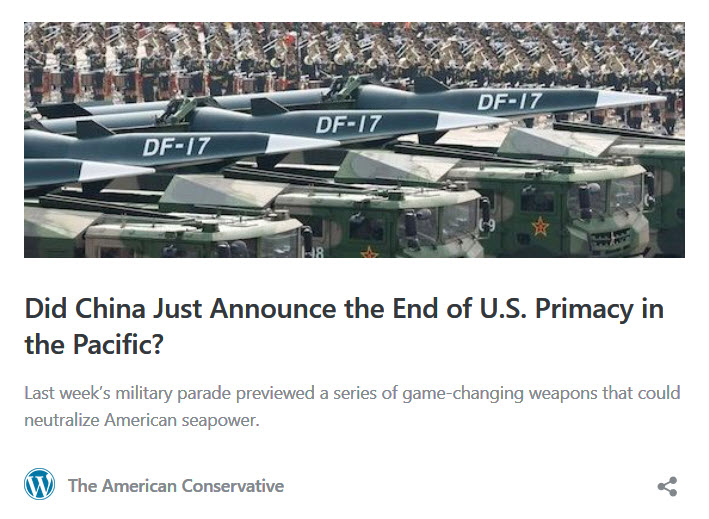
The ghosts of Opium Wars and the Century of Humiliation made sure that China was prepared for this moment.
A Failed Trump Trade Policy
Trump’s trade war with China is clearly a net failure. Trump could have gotten the same deal back in 2018, more than a year ago. Instead, the dispute was allowed to escalate, with the effect of causing business uncertainty and slowing investment in the US and worldwide due to the 15 month trade war.
The trade war has clearly played a part in the global manufacturing recession now underway, which threatens now to spread to services and consumption and precipitate a general recession in the US economy and possibly even worldwide.
Trump has pushed the global economy to the brink of a worldwide currency war in the process as well. He has drained $28 billion thus far from business and consumer spending in order to collect tariff revenues that he’s diverted in turn to the farm sector in subsidies that otherwise might not have been necessary. Small business, household consumers, and failing small farmers have paid the price and will continue to do so in higher prices from continuing tariffs.
Despite 15 months of trade war with China—and a series of ‘softball’ trade deals with South Korea, Japan, and Mexico-Canada—the US trade deficit as of August 2019 has reached record deficit levels of $55 billion that month and an annual rate of nearly $700 billion a year. The trade wars have been totally ineffective in reducing the US trade deficit—if that was ever the goal.
If we look at the ratio of #exports to #GDP (currently 19.51%) and the #distribution by country (just about 20% to the #US), we realize that only about 3.9% of #China's GDP is coming from exports to the US. That is less than the annual growth of GDP. In other words, China's #economy grows by much more than all the exports to the US - every year. This puts the potential pressure the #USA can put on China via protectionist policies in quite some perspective. Of course, the actual exports have a multiplier, as suppliers to exporting companies would also suffer from a further closing down of the US economy. But the main message remains: 80% of Chinese exports don't go to the US (and increasing as trade with #Africa grows), and overall the Chinese economy is less and less dependent of foreign #currency coming from exports. #TradeWar -Harold Bachmann
Now some humorous Dilbert on this matter…
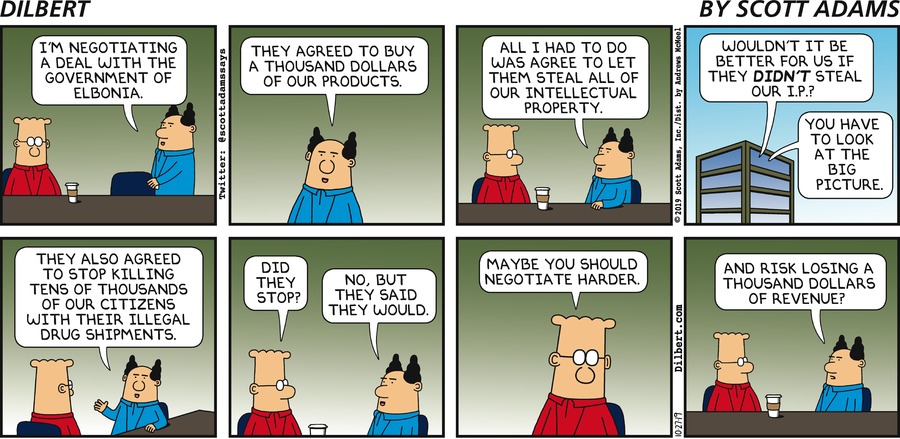
Links about China
Here are some links about my observations on China. I think that you, the reader, might find them to be of interest. Please kindly enjoy.
































China and America Comparisons
As an American, I cannot help but compare what my life was in the United States with what it is like living in China. Here we discuss that.














The Chinese Business KTV Experience
This is the real deal. Forget about all that nonsense that you find in the British tabloids and an occasional write up in the American liberal press. This is the reality. Read or not.




















Learning About China
Who doesn’t like to look at pretty girls? Ugly girls? Here we discuss what China is like by looking at videos of pretty girls doing things in China.





Contemporaneous Chinese Music
This is a series of posts that discuss contemporaneous popular music in China. It is a wide ranging and broad spectrum of travel, and at that, all that I am able to provide is the flimsiest of overviews. However, this series of posts should serve as a great starting place for investigation and enjoyment.


















Parks in China
The parks in China are very unique. They are enormous and tend to be very mountainous. Here we take a look at this most interesting of subjects.









Really Strange China
Here are some posts that discuss a number of things about China that might seem odd, or strange to Westerners. Some of the things are everyday events, while others are just representative of the differences in culture.














What is China like?
The purpose of this post is to illustrate that the rest of the world, outside of America, has moved on with their lives. That while they might not be as great as America is, they are doing just fine thank you.
And while America has been squandering it’s money, decimating it’s resources, and just being cavalier with it’s military, the rest of the world has done the opposite. They have husbanded their day to day fortunes, and you can see this in their day-to-day lives.









Summer in Asia
Let’s take a moment to explore Asia. That includes China, but also includes such places as Vietnam, Thailand, Japan and others…












Some Fun Videos
Here’s a collection of some fun videos taken all over Asia. While there are many videos taken in China, we also have some taken in Thailand, Vietnam, Cambodia, Korea and Japan as well. It’s all in fun.

















Articles & Links
You’ll not find any big banners or popups here talking about cookies and privacy notices. There are no ads on this site (aside from the hosting ads – a necessary evil). Functionally and fundamentally, I just don’t make money off of this blog. It is NOT monetized. Finally, I don’t track you because I just don’t care to.
- You can start reading the articles sequentially by going HERE.
- You can visit the Index Page HERE to explore by article subject.
- You can also ask the author some questions. You can go HERE to find out how to go about this.
- You can find out more about the author HERE.
- If you have concerns or complaints, you can go HERE.
- If you want to make a donation, you can go HERE.

